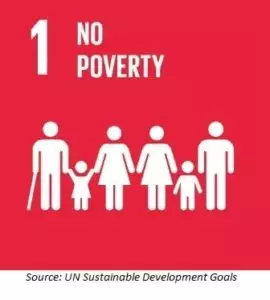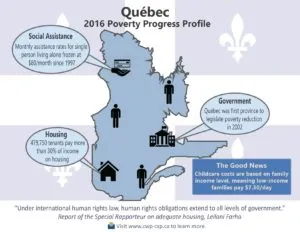2017 is shaping up to be a bold new year for the relief of poverty in Canada! With the fresh start and Canadian Poverty Reduction Strategy on the horizon, it’s a great time to gather up our new year’s resolutions, and start creating ‘to-do’ lists to make it all happen.
As CWP puts together our goals for the year, we’re making lots of lists. With that theme in mind, we decided revisit a popular ‘list’ blog we put together in 2014 featuring the top 10 reasons to why poverty must be eliminated in Canada.
To celebrate a new year full of possibilities we’ve revised the list and added 7 more reasons why ending poverty must be at the top of the federal government’s priority list in 2017. Check it out below.
17. Canadian Parliamentarians have already promised to end poverty. In 1989, the House of Commons unanimously committed to a motion to end child poverty. This motion was revisited 26 years later in 2015, when the House voted in favour of the motion a second time. Despite these commitments, 1.3 million children in Canada currently live in poverty. These numbers are even more shocking for marginalized groups. According to a study released in March 2016, a shameful 60% of First Nations child ren on reserve live in poverty.
ren on reserve live in poverty.
16. There is recent international momentum to end poverty that Canada can build on. A growing movement has mobilized to prioritize poverty, hunger and homelessness. In 2016, governments – including Canada – were encouraged to use the Habitat III process as a key opportunity to end homelessness, including its systemic causes, by the year 2030. The Sustainable Development Goals, which Canada has supported, specify the need to “end poverty in all its forms everywhere”.
15. Poverty can happen to anyone. Causes of poverty are diverse and can include domestic violence, loss of employment, and health problems. It’s long past time to recognize that poverty is not the result of personal failure, but of the government’s failure to recognize the right to an adequate standard of living and to ensure that the social safety net is strong enough to capture those who need it.
14. Poverty actually affects how long people live. A McMaster Study found a 21-year difference in life expectancy between inhabitants of the poorest neighbourhood and those in the wealthiest neighbourhood in Hamilton, Ontario. Additionally, there is a strong connection between women’s homelessness, premature death, and domestic violence. This was demonstrated in a Toronto study, which found that homeless women 18 to 44 years old are 10 times more likely to die than women of the same age group in the general population.
13. We have no excuse not to. Canada is a wealthy country with many resources. We have one of the highest GDPs in the world. In fact, at last count Canada had the 10th highest Gross Domestic Product just behind India, Italy, and Brazil.
12. If Canada wants to position itself as a global leader of equality, it has to take serious action to address poverty. Marginalized groups including racialized persons, newcomers, Indigenous persons, persons with disabilities, and women experience poverty at disproportionate rates. Recently, the United Nations has commented on this inequality in reviews of Canada by the Committee on the Elimination of Discrimination against Women (CEDAW) and the Committee on Economic, Social and Cultural Rights (CESCR).
11. We have a lot of room to grow our commitment to poverty. Canada’s social spending is actually lower than you may think. In fact, federal government spending, as a share of GDP, is at its lowest level since 1949.
10. Studies have demonstrated that poverty creates obstacles to learning and academic achievement for children. Poverty can affect areas such as mobility, access to material resources, and health – holding children back from achieving their full potential.
9. There is a pressing need to address senior poverty in Canada. One in nine seniors, or 11%, lived in poverty in 2013. This is a staggering increase from 3.9% in 1995. The Baby Boomer generation makes up 27% of the total population; for the first time, Canada has more people over the age 65 than under the age 15. As the Boomer generation ages, the rate of senior poverty will continue to rise and the social safety net will be further strained by demands for low-cost housing, OAS and GIS, and increased healthcare.
8. Poverty costs people in Canada A LOT of money. From greater usage of criminal justice and healthcare systems to diminished economic activity, poverty comes at a significant cost for Canadians. While it’s difficult to calculate the precise cost of poverty, a report from Ontario states that poverty costs the provincial and federal government between $10.4 billion and $13.1 billion a year. Similarly, in Saskatchewan poverty costs are estimated at $3.8 in heightened service use and missed opportunity and in British Columbia, the government spends between $8.1 and $9.2 billion on poverty.
7. Poverty affects people’s quality of life, including their health. One-in-ten Canadian households have someone who did not fill a prescription because of cost. As a Toronto physician recently stated in an editorial: “poverty is at the root of many of the illnesses I treat.”
6. If Canada wants to move past a legacy of colonialism towards reconciliation, we have to take action on poverty – especially for Indigenous communities. It comes as no surprise that poverty rates among Indigenous persons on and off reserve are abysmal. In particular, Indigenous women experience high rates of poverty, with 37% of First Nations women (off reserve) and 23% of Metis and Inuit women living in poverty compared to the 13.5% of women overall in Canada.
5. Government committe es within both the House of Commons and Senate have already told Canada that we must prioritize poverty over six years ago. Both the HUMA Committee in 2010 and the in the Standing Senate Committee on Social Affairs, Science and Technology in 2009 have recommended that the government take action in developing a rights-based national poverty plan. While initiatives to consult the public on a national plan are now underway, this strategy is long overdue.
es within both the House of Commons and Senate have already told Canada that we must prioritize poverty over six years ago. Both the HUMA Committee in 2010 and the in the Standing Senate Committee on Social Affairs, Science and Technology in 2009 have recommended that the government take action in developing a rights-based national poverty plan. While initiatives to consult the public on a national plan are now underway, this strategy is long overdue.
4. Canada’s international human rights reputation is at stake as we keep falling below expectations through inaction. While Canada has historically received applause for being an international human rights leader on civil and political rights, this leadership does not extend to the recognition of economic and social rights.
3. Provinces, territories, and regional governments have long played a role in poverty alleviation, but the federal government has lagged behind. In particular, Newfoundland and Labrador, as well as Québec, have made significant process through their provincial poverty strategies. To learn about poverty strategies in each province and territory check out CWP’s 2016 Poverty Progress Profiles.
 2. Canada is LEGALLY obligated to address poverty. Canada is required to fulfill the human rights obligations listed in the international instruments that we have ratified or adopted. Many of these instruments cite the right to an adequate standard of living including the Universal Declaration of Human Rights (ratified by Canada in 1949), the Covenant on Economic, Social and Cultural Rights (ratified by Canada in 1976) and the recent Convention on the Rights of Persons with Disabilities (ratified by Canada in 2010).
2. Canada is LEGALLY obligated to address poverty. Canada is required to fulfill the human rights obligations listed in the international instruments that we have ratified or adopted. Many of these instruments cite the right to an adequate standard of living including the Universal Declaration of Human Rights (ratified by Canada in 1949), the Covenant on Economic, Social and Cultural Rights (ratified by Canada in 1976) and the recent Convention on the Rights of Persons with Disabilities (ratified by Canada in 2010).
1. We can no longer ignore the human reality of poverty. There are 4,900,000 reasons to end poverty in Canada – one for every person in Canada who has to decide between buying enough food for their family or paying the hydro bill to keep the heat on in during the winter.
There are so many more reasons that now is the time to act. With a National Housing Strategy, Canadian Poverty Reduction Strategy, and other anti-poverty initiatives in development, it seems that the federal government might finally be stepping up to address this crisis. With a new year ahead, we’ll be making our own resolution to ensure that ending poverty in Canada stays right the top of their ‘to-do’ list for 2017.

